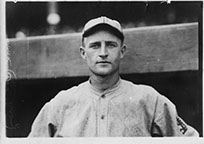By James Jerpe, Who Attended
October 25, 1914 Age 23
By JAMES JERPE. Pittsburgh Post Gazette
Among the stories told on Bill Doak at Friday night’s reception concerned Ham Hyatt. Ham failed to touch Bill when sent to bat in a pinch one day in St. Louis. Walking up to Rube Roblnson the next day Ham asked: What’s that guy Doak got anyhow, Rube?” “Well, I’ll tell you. Ham.” replied Robby drawing Ham to one side. “He is jest like Matty, Babe, Alexander, and some of these other lucky stiffs what wins ball games. He ain’t got a thing.”
Someone at Bill Doak’s reception on Friday night popped the question as to why the Pirate management has overlooked so many baseball stars in and around Pittsburgh, particularly those who graduated from the lots and meadows of the South Hills. In 1911 the Pirate management paid $22,500 for an O’Toole where they might have secured a Doak for $1,500. It has been that way all along.
They all looked good when they were far away, but local talent of high merit was allowed to drift elsewhere. Pittsburgh has been one of the great producing centers of baseball talent for a quarter century, but statistics show that the old and present Pirate managements could seldom see merit in local beginners. A few tossers who saw their first major league service in their hometown were Frank Killen, the veteran left-hander of the ‘nineties; Bill McKechnie and Hans Lobert. Otto Knabe also was signed to a Pirate contract but he and Lobert were both allowed to drift away, although Pittsburgh later made a desperate attempt to get Lobert back but lost out through the double-dealing of the Des Moines club.
The Pittsburgh district in 1896 harbored Hans Wagner, the greatest player in the world, but the local management was not aware of the fact and preferred to heed the recommendations of the blase scouts concerning the bush talent from afar. Honus was signed to a Pirate contract as early as 1896, but he was sent to Paterson without being allowed to don a Pirate uniform. Louisville then got him and Honus came here with the remnant of the Colonels in 1900.
Another great star in his time who flashed on local lots and then starred elsewhere was Frank (Nig) Smith, the Herron Hill pitcher, who proved the mainstay of the White Sox in the palmiest days of Comiskey’s team. All the Pirate management needed to do to engage Smith would have been to mail him a postcard. Rube Waddell was a sensation hereabouts in the days of the old Pirate management, but they could not see him. Waddell reached Pittsburgh eventually by the same route that Wagner got here.
Following are some players born and reared in the Pittsburgh district who served in major league company without ever getting a trial with Pittsburgh: Nig Smith, Enos Kirkpatrick, Elmer Knetzer, Tools Shultz, Jim Shaw, Bill Steen, Jimmy Pastorious, Billie Campbell, Marty Berghammer, Bill Doak, Sam Griffith, Tommy Murray, Chuck Deal, Bill Louden, Bobby Wallace, Gus Getz, Joe Schultz, Whitey Alperman, Otto Knabe, and a dozen others.
There are few stars among those mentioned above but the lot in the aggregate certainly shapes up better than any corresponding number of recruits ever feathered in from distant points by Pirate scouts. It would pay the Pirate management to locate watch towers for scouts at Washington park, the Bedford basin, D. C.& A. C. Park in Wilkinsburg, on the Denny grounds and in Knoxville, Carrick, Beltzhoover and other Pittsburgh communities, where they are turning out future stars like Wagner, Nig Smith, Lobert, Doak, Knabe, Wallace and others. But the ivory hunters work on the theory that they all look good when they are far away.
